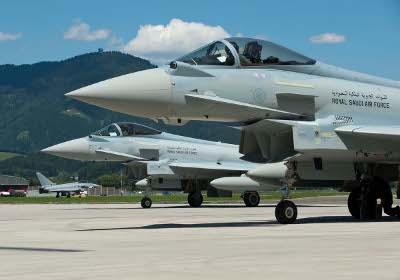Saudi Typhoon storms ahead
Saudi Arabia has faced challenges introducing the Eurofighter Typhoon into service, not least in establishing local production – which has yet to start. But, as Jon Lake reports, despite this the Royal Saudi Air Force is pushing hard to adopt new capabilities and is believed to have been driving the pace of the development of new air-to-ground capabilities for the tranche 2 aeroplane.
Many analysts believe that the pace of development for the phase 1 enhanced (P1E) programme of the Saudi Arabian Typhoons has been more rapid than might have been expected in the light of budgetary pressures among the four partner nations.
One possible explanation could be Saudi funding. But even if Saudi Arabia is not actually bankrolling P1E, there is no doubt that the kingdom is at least closely following, and perhaps enthusiastically supporting, the latest developments.
In last year’s BAE Systems annual report, it was revealed that Saudi Arabia intended that at least the final 24 of the 72 Eurofighter Typhoons it has on order would be delivered with provision to be upgraded to full tranche 3 standards.
The tranche 3 Typhoon will have full air-to-ground capability, including the integration of weapons like the MBDA Storm Shadow cruise missile and the smaller Brimstone PGM, as well as an advanced AESA radar, providing expanded electronic attack capabilities.
The kingdom seems to be placing greater emphasis on Typhoon’s air-to-ground capabilities, both for the long-term and in the more immediate future.
Writing in the Washington Post, defence commentator David Ignatius suggested that, as part of a wider more assertive policy, Saudi Arabia was planning to double its armed forces over the next 10 years, while simultaneously modernising many capabilities. Ignatius said the Royal Saudi Air Force (RSAF) would introduce between 450 and 500 new aircraft as part of this process, including 84 F-15SA Silent Eagles and a further 72 Typhoons. Likely timescales mean that any second batch of Typhoons would be delivered to tranche 3 standards.
Previously it had been thought that the Saudis would buy one type or the other and not both, but it now seems that tranche 3 Typhoons will provide the offensive backbone of the air force augmented by new and refurbished F-15s and, indeed, by the surviving Tornados upgraded under the TSP programme.
The advantage of the Typhoon to the Saudis is that it is more likely that specific weapons and defensive capabilities would be cleared and integrated, since Israeli pressure on the USA has historically limited weapons integration on American-built aircraft supplied to Arab air forces.
Prince Sultan’s stated intent for Saudi Arabia to have “200-plus” Typhoons in RSAF service by 2015 no longer looks fanciful.
But tranche 3 is still some way off and all 24 of the Typhoons now delivered to Saudi Arabia are from tranche 2. To meet Saudi timescales, these first 24 RSAF Typhoons (18 single-seat and six trainers) were aircraft that were taking shape on the production line for the British Royal Air Force, and that were diverted to meet Saudi requirements.
Production was then to have switched to a new facility built by BAE Systems at King Abdulaziz airbase at Dhahran. Work on this facility (which was to incorporate a Typhoon technical zone for local production) began with the ceremonial laying of a foundation stone by defence and aviation minister Prince Sultan in March 2008. The facility was supposed to have been completed in August 2009, with work beginning in the second quarter of 2010 and the first locally-assembled Typhoon due to be completed in 2011. But the in-kingdom industrial programme (IKIP) failed to materialise.
It now seems likely the remaining 48 Typhoon aircraft ordered by Saudi Arabia will be built in Britain, though an in-kingdom maintenance and upgrade facility may still be established. Production of these 48 aircraft seems to have stalled while contract details are renegotiated. Local production was to have been a vital feature of ‘Project Salam’ aiming to kick-start an indigenous Saudi aerospace and defence industry with thousands of high-value jobs. Losing this element of the programme is a bitter blow and the kingdom is believed to be working hard to extract concessions from the UK to “make up” for the loss.
It is believed that the Saudis are keen for the remaining aircraft in its order to have the best possible air-to-ground capabilities.
Historically the RSAF has always tended to shadow the RAF and USAF when bringing new types and new capabilities into service. With its UK-supplied combat aircraft, any new functionality has first been cleared and underwritten by the UK MoD and QinetiQ before being released to the RSAF. But Saudi Arabia is becoming more confident and proactive and has aspirations to become its own engineering and release authority.
The RSAF, therefore, started air-to-air gunnery (something the RAF still has not done) and began mounting quantitative risk assessment (QRA) operations with its tranche 2 aircraft before the RAF.
Nor did the Saudis slavishly follow the RAF’s choice of air-to-air weapons. Though RSAF Typhoons do use the Raytheon AIM-120C5 AMRAAM for BVR air combat engagements, for short-range use it selected the Diehl BGT Defence IRIS-T short-range air-to-air missile, rather than the MBDA ASRAAM favoured by the UK.
But the Saudis were keen to follow (or match) the partner nations in their drive for expanded air-to-ground capabilities on phase 1 enhancement, part A (P1EA). It was reported that when the RSAF was briefed P1EA its representatives simply said: “That’s great! When can we have it?”
Arabian Aerospace has learned that the RSAF has now become the first Typhoon operator to start better ground operations using tranche 2 aircraft – which will not gain a full air-to-ground capability until the P1EA is released in mid 2012.
The RSAF’s No3 Squadron began air-to-ground operations in December 2011 as part of a phased work-up, which will culminate in the full exploitation of P1EA when it becomes available.
Since the 24 Typhoons delivered to Saudi Arabia all serve with No10 Squadron, the RSAF’s Typhoon OEU, and No3 Squadron, the Saudi Typhoon operational conversion/training unit, the early part of the phased work-up is believed to be primarily aimed at building up a cadre of air-to-ground weapons instructors (QWIs) and evaluator pilots, whose skills will be ‘grown’ as the aircraft’s capabilities are expanded.
Because the tranche 2 Typhoon introduced new computer hardware, the decision was taken to adopt a simple software load (known as SRP 5.0/5.1) based on the tranche 1 SRP 4.0 software. The tranche 1 software has since moved on, with SRP 4.2 providing the austere air-to-ground capability, and with SRP 4.3 and a series of post-main development contract software ‘drops’ providing further refinements and enhancements.
This means that tranche 1 aircraft have features, functionalities and capabilities that tranche 2 aircraft do not. Most obviously the tranche 2 jets do not have the austere air-to-ground capability provided under CP 193 (change proposal 193) and recently combat-proven in Libya.
Tranche 2 aircraft can, of course, carry and drop a range of air-to-ground weapons, including the UK Paveway II laser-guided bomb and GBU-16, but they are not cleared for strafe (using the internal 27mm Mauser cannon in the air-to-surface role), nor do they have a laser designator pod.
However, with support from off-board designators (either ground-based or airborne) the tranche 2 Typhoon can already employ laser-guided bombs and No3 Squadron is expected to work with Tornados carrying the French Damocles laser designation pod. The tranche 2 aircraft, thus, already has an air-to-surface capability that is better than merely ‘rudimentary’.
With the anticipated release of P1EA this summer there is little need for any interim air-to-ground capability on the tranche 2 aircraft and, indeed, any such programme could only have delayed P1EA and other important on-going programmes, including P1EB, Meteor integration, and SRP 14.
P1EA is very close to service. Typhoons have now carried out a significant number of full avionic functional releases (‘avionics integrated releases’) of the Paveway IV, and have used the Litening 3 LDP to guide them. The full end-to-end autonomous designation capability will be tested during the first quarter of 2012.
Service aircrew from the RAF’s No17 Squadron have been involved in these trials, and have flown the new software standard extensively in the rig, and in instrumented series production aircraft.



![-- :walw[1]: :walw[1]:](/vb/data/assets/smilies/c39c84e393dbca960a05b9f45e20e07203df7b3c.gif)
